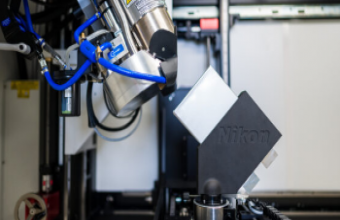Nikon Corporation's Industrial Metrology Business Unit has introduced LiB.Overhang Analysis software, powered by artificial intelligence (AI), for inspecting and analyzing anode overhang in lithium-ion battery (LiB) cells. The software uses 3D X-ray scanning and computed tomography (CT) during mass production, providing automatic, precise, and consistent analysis, which is essential for short inspection cycles. The solution enables high production yields, meeting the increasing market demand for batteries, and results in fewer expensive warranty claims from users of electric vehicles, energy storage systems, and other battery-powered equipment.
The LiB. Overhang Analysis software solution encourages more in-line inspection earlier in manufacturing to improve product quality. Nikon offers a complete solution by combining the new analysis approach with its microfocus X-ray source, rotating target, and Half. Turn CT technologies.
The anode in a LiB cell is larger than the cathode to prevent lithium plating and possible dendrite formation. Therefore, there are passive areas on the anode known as overhang regions that are not opposed by corresponding areas of the cathode. Their dimensions must consistently be within close limits; otherwise, battery performance may be reduced, and it may spontaneously combust in extreme cases. Therefore, it is critically important to analyze anode overhang.
Traditional 2D radiography inspection is fast but does not provide results that are precise or repeatable enough, as it is challenging to distinguish individual layers with a single cone-beam radiograph, especially when the sheets are not perfectly flat. Automation of overhang analysis by 3D X-ray CT eliminates these difficulties. The LiB. Overhang Analysis software is fast enough to cope with the speed of production lines as it is less sensitive to noise in 3D images acquired by high-speed scanning. Nikon's advanced machine learning AI model uses prior information to identify and classify anode overhang features and flaws in cells, regardless of the presence of typical noise and scan artifacts. The LiB. Overhang Analysis software is fine-tuned for the manufacturer's XT H-series of X-ray CT systems, allowing battery cells to be scanned accurately and reliably, either in-line or line-side in a factory.
Nikon's new software automatically calculates anode overhangs for each layer in the anode/cathode stack, generating numerical measurements of critical features. This provides customers with statistics relevant to their needs, allowing assembly issues to be detected and quantified early so that data can be fed back to optimize the production process, increasing throughput and reducing scrap. The inspection data can be stored in a manufacturing execution system database to allow full traceability of each individual cell, consistent with Quality 4.0 practices.
Nikon's microfocus X-ray sources, rotating target, and Half. Turn CT technologies play a crucial role in the success of this inspection application, allowing high-speed data acquisition. The solution harnesses the penetrating capability of the company's powerful microfocus X-ray sources and the unique Rotating. Target 2.0, which spins to dissipate the heat generated by the small spot of electrons impinging on the tungsten surface, enables higher power than is otherwise possible. Additionally, Nikon's Half. Turn CT may be deployed, allowing the sample under investigation to rotate just over 180° to obtain sufficient data for an image of equivalent quality, doubling inspection efficiency.












